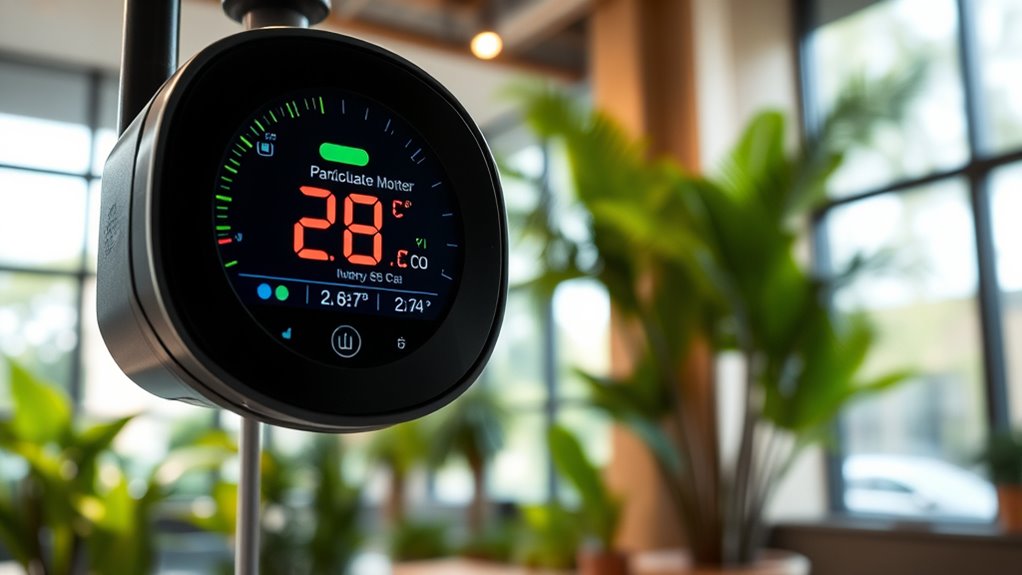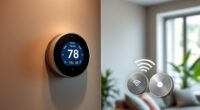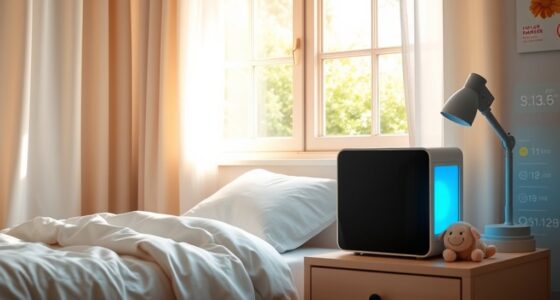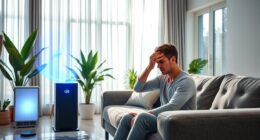Indoor air quality standards from agencies like the EPA and WHO set safe limits on pollutants such as VOCs, particulate matter, and carbon monoxide to protect your health. These guidelines help you understand which levels of indoor pollutants are safe and when to take action. They also guide the use of proper ventilation and air filtration systems. To learn more about how these standards can keep your indoor environment safe, keep exploring this important topic.
Key Takeaways
- Indoor air quality standards set safe pollutant concentration limits to protect health in homes and workplaces.
- EPA and WHO provide guidelines based on scientific research linking pollutant levels to health risks.
- Thresholds help evaluate ventilation and filtration systems to ensure indoor air remains within safe limits.
- Adhering to standards reduces risks of respiratory issues, allergies, and other health problems caused by indoor pollutants.
- Standards guide the implementation of effective air filtration and pollution source management for healthier indoor environments.

Indoor air quality standards are essential guidelines that help make sure the air inside your home or workplace remains safe and healthy. These standards set clear limits on the concentration of various pollutants to protect you from potential health risks. You might not realize it, but the air you breathe indoors can contain allergens, chemicals, and other harmful particles that build up over time. That’s where air filtration and pollutant thresholds come into play. They’re designed to reduce your exposure to these contaminants and ensure that indoor air remains within safe levels.
When organizations like the EPA and WHO establish indoor air quality standards, they focus considerably on air filtration. Effective air filtration systems are vital because they can actively remove pollutants from the air, such as dust, pollen, pet dander, mold spores, and even chemical vapors. These systems help maintain pollutant levels below the thresholds deemed safe by health authorities. For example, high-efficiency particulate air (HEPA) filters are known to trap tiny particles that could otherwise circulate freely in your indoor environment. Proper air filtration isn’t just about installing a filter; it’s about ensuring that the filter’s capacity aligns with the pollutant thresholds set by these standards. Additionally, air filtration technology continues to advance, offering even more effective solutions for maintaining healthy indoor air quality.
Effective air filtration removes pollutants and maintains safe indoor air quality levels.
Pollutant thresholds are the maximum allowable concentrations of specific contaminants in indoor air. The EPA, for instance, provides guidelines that specify safe levels for common indoor pollutants like volatile organic compounds (VOCs), carbon monoxide, and particulate matter. The WHO offers similar recommendations, emphasizing that keeping pollutant levels below these thresholds can markedly reduce health risks, especially for vulnerable populations like children, the elderly, or those with respiratory conditions. These thresholds aren’t arbitrary—they’re based on scientific research linking specific pollutant concentrations to health outcomes. When indoor air exceeds these limits, the risk of issues such as asthma attacks, lung irritation, or other respiratory problems increases.
Understanding these standards empowers you to take control of your indoor environment. For instance, if you know the pollutant thresholds, you can evaluate whether your current ventilation and filtration systems are enough or if upgrades are necessary. Regular maintenance of your filters and proper ventilation can help keep indoor pollutant levels below the recommended thresholds. Additionally, being aware of sources of indoor pollution—like smoking indoors, using certain cleaning products, or poor ventilation—allows you to minimize your exposure. In the end, aligning your indoor air quality practices with established standards ensures a healthier, safer environment for everyone inside your home or workplace.
Frequently Asked Questions
How Often Are Indoor Air Quality Standards Updated?
Indoor air quality standards are updated periodically, usually every few years, based on new research and air quality monitoring data. You should stay informed because policy enforcement can change as standards develop. Regular updates help ensure safety, but it’s your responsibility to check for the latest standards. By keeping track of these updates, you can better protect yourself and others from indoor pollutants and maintain a healthier environment.
Do Standards Differ for Residential and Commercial Buildings?
Yes, standards differ for residential and commercial buildings. You’ll find that building codes set specific ventilation requirements tailored to each type. Residential standards often focus on air exchange rates and pollutant limits to protect occupants, while commercial standards emphasize maintaining air quality for larger spaces and higher occupancy. These differences guarantee both environments promote healthier indoor air, but they’re customized to meet the unique needs of each setting.
Are There Regional Variations in Air Quality Standards Globally?
You might think air quality standards are uniform worldwide, but ironically, regional differences exist. These variations reflect local policies, economic priorities, and health concerns, leading to different thresholds for pollutants. Such disparities have major policy implications, making it tricky to guarantee consistent indoor air quality globally. You need to recognize these regional differences, as they directly influence regulations, enforcement, and your overall health environment in different parts of the world.
How Do Indoor Air Standards Address Emerging Pollutants?
Indoor air standards address emerging pollutants by setting limits on indoor pollutants based on latest scientific research, guaranteeing they protect health. You’re encouraged to stay informed about updates, as standards evolve with new findings. Standard enforcement involves regular monitoring and testing, helping identify and control indoor pollutants promptly. This proactive approach ensures that indoor environments remain safe, even as new pollutants appear, safeguarding your health and well-being.
What Are the Health Implications of Exceeding These Standards?
Exceeding indoor air quality standards puts you at risk of various health issues, including respiratory problems, allergies, and asthma. Long-term effects may involve chronic lung diseases, cardiovascular issues, or even cancer. When pollutants like VOCs, particulates, or molds surpass safe limits, your body’s defenses weaken, increasing vulnerability to infections. To protect your health, it’s vital to maintain indoor air quality within recommended standards and address pollution sources promptly.
Conclusion
So, after all this talk about standards and guidelines, you might think your indoor air is perfectly safe. But here’s the irony: these standards are just guidelines, not guarantees. Even with regulations in place, indoor air quality can still be a hidden hazard. So, next time you breathe easy indoors, remember—sometimes, the air you trust the most is the one you might want to question. Stay vigilant—your health might depend on it.









